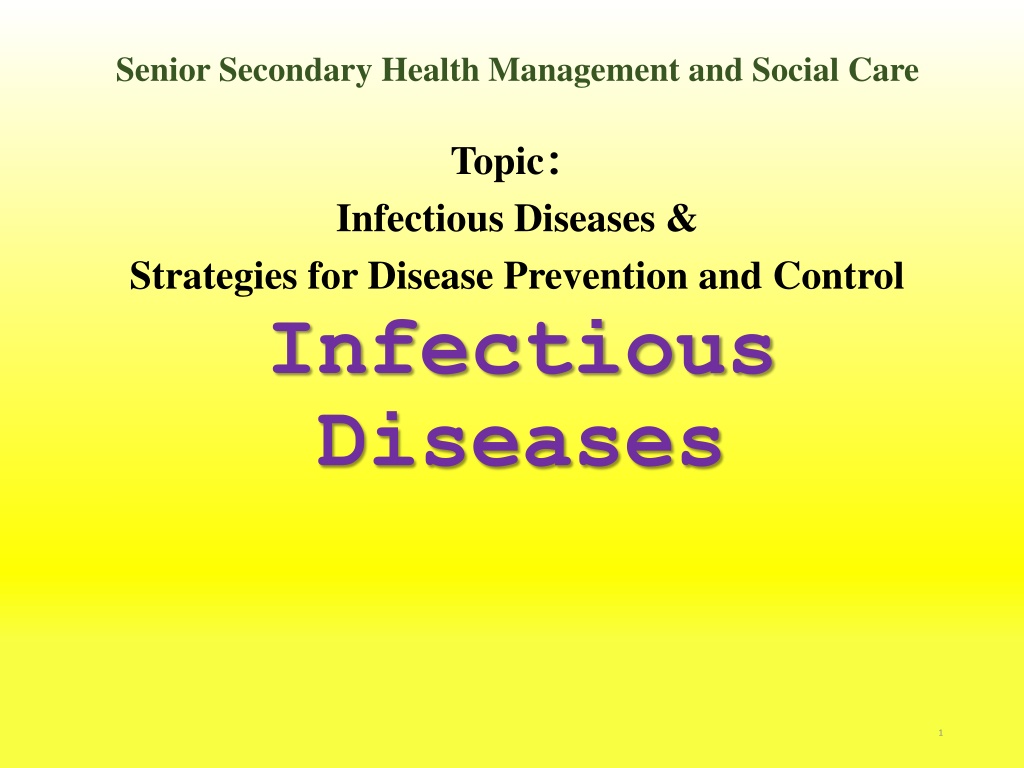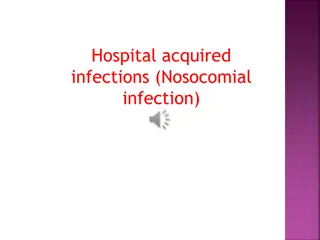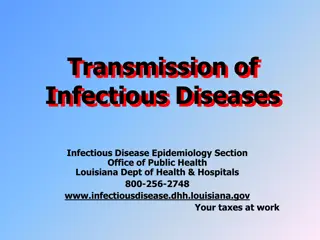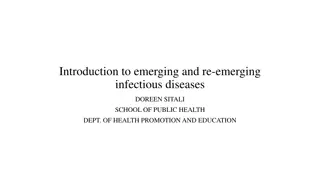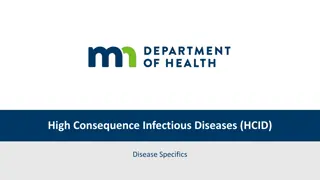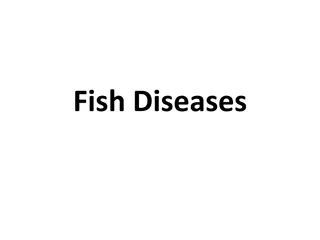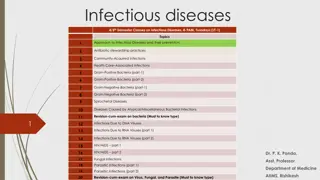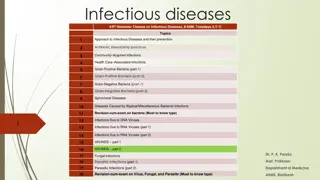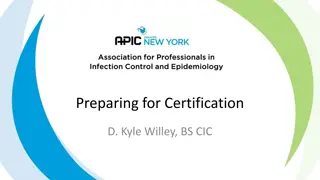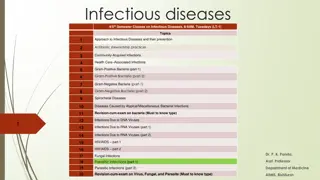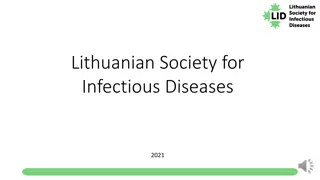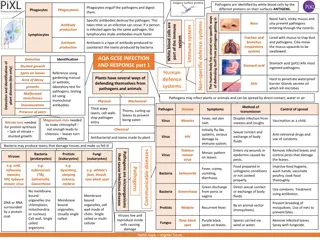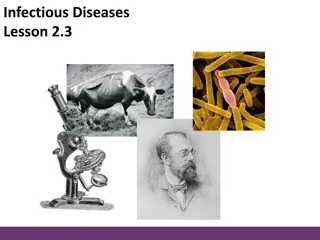Understanding Infectious Diseases and Prevention Strategies
Infectious diseases are caused by pathogens like bacteria, viruses, parasites, or fungi invading the body. These diseases can spread from person to person and sometimes from animals to humans. Common characteristics include potential severe outcomes, transmission modes, and the role of pathogens. The epidemiologic triangle helps study disease outbreaks by considering the host, agent, and environment. Pathogens like viruses, bacteria, fungi, and parasites play crucial roles in disease occurrence. Understanding these agents can aid in developing effective prevention and control measures against infectious diseases.
Download Presentation

Please find below an Image/Link to download the presentation.
The content on the website is provided AS IS for your information and personal use only. It may not be sold, licensed, or shared on other websites without obtaining consent from the author. Download presentation by click this link. If you encounter any issues during the download, it is possible that the publisher has removed the file from their server.
E N D
Presentation Transcript
Senior Secondary Health Management and Social Care Topic Infectious Diseases & Strategies for Disease Prevention and Control Infectious Diseases 1
Activity (1) Which of the following are infectious diseases? a) Diabetes b) Acquired immune deficiency syndrome (AIDS) c) Poliomyelitis d) Coronary heart disease e) Schizophrenia f) Middle East Respiratory Syndrome g) Japanese encephalitis h) Cerebrovascular disease i) Chickenpox What are the common characteristics of infectious diseases? 2
What are infectious diseases? Pathogens include bacteria, viruses, parasites or fungi caused by the invasion of pathogens. Pathogens may release toxins and damage normal body cells and their functions. It may result in death in severe cases can spread, directly or indirectly, from one person to another Zoonotic diseases are infectious diseases of animals that can cause disease when transmitted to humans 3
Triangle of Communicable Diseases/ Epidemiologic Triangle A framework frequently used by epidemiologists when studying disease outbreaks Host Epidemiologic Triangle Agent Environment 4
The Agent / Pathogen1 Pathogens include bacteria, viruses, parasites or fungi Generally, a pathogen must be present for disease to occur; however, presence of that pathogen alone is not always sufficient to cause disease A variety of factors influence whether exposure to the pathogen will result in disease, including the pathogenicity and dose of the pathogen 5
The Agent / Pathogen (2 Viruses Bacteria Fungi Parasites Many have a spiny outside layer, called the envelope. Viruses have a core of genetic material, but no way to reproduce it on their own. Viruses infect cells and take over their reproductive machinery to reproduce Example: influenza viruses, human immunodeficiency virus (HIV) They are single- celled organisms that can reproduce themselves. Most of them are larger than viruses but still much too small to be seen with the naked eye Examples: Staphylococcus They are made up of many cells. They cannot produce their own food. Instead, they live off animals / plants. They can grow in or on the body, causing infections of internal organs or of the skin, hair, and nails Examples: Candida They are bigger than viruses and bacteria in size. They must live on or inside a human or other organisms to survive Examples: intestinal parasites include roundworms, pinworms, hookworms, tapeworms and liver flukes 6
The Agent / Pathogen (3 Pathogenicity Infectivity Virulence the ability of a pathogen to cause severe disease, measured as the proportion of hosts with the disease who become severely ill or die severe symptoms, such as dengue hemorrhage; serious complications, such as life-long physical disability caused by poliomyelitis the ability of a pathogen to cause disease after infection, measured as the proportion of hosts infected by the pathogen who then experience clinical disease examples of highly pathogenic diseases are smallpox, measles, chickenpox, rabies the ability of a pathogen to cause infection, measured as the proportion of hosts exposed to the pathogen who become infected examples of acute infectious diseases are smallpox, measles, chickenpox 7
The Host Who is the host? humans or animals exposed to a pathogen and harbor a disease Infection Illness Infection only refers to the invasion of the body tissues of a host by a pathogen. A host infected by a pathogen may not always exhibit clinical symptoms. It also depends on the immunity of the host. Some people are more prone to disease after infection. For instance, young children and patients with chronic diseases are more susceptible to complications after infection due to insufficient body immunity. Adults infected with the virus varicella (chickenpox) are more likely than children to develop serious complications. Other factors include the dose of pathogens as well as the sex, socioeconomic status, behavioural risk factors and susceptibility to infection of the hosts 8
The Environment The environment is the favourable conditions external to the host that cause or allow the pathogen to be transmitted. General sanitation, temperature, air pollution and water quality are the factors that influence all stages of in the chain of infection. Socioeconomic factors include overcrowding living environment and poverty etc.. For example, E. Coli thrive in warm temperatures but are killed by high heat. Flu is seasonal and it usually occurs in the winter. 9
Activity (2) The epidemiologic triangle helps the experts understand how to prevent and control disease outbreaks. The spread of the disease is controlled by breaking any one side of the Triangle to disrupt the connection between the environment, the host, and the agent Search for the information about the Coronavirus disease 2019 in the following websites and organise the information with the epidemiologic triangle: Centre for Health Protection Coronavirus Disease 2019 https://www.coronavirus.gov.hk/eng/index.html World Health Organization - Coronavirus Disease 2019 https://www.who.int/emergencies/diseases/novel-coronavirus-2019 COVID-19 Agent Host Environment 10
Infectious diseases occur as a result of the interaction between: The infectious agent The transmission process The host The environment Understanding the transmission process: chain of infection 11
Chain of Infection A pathogen enters another host must provide access to tissues in which the pathogen can multiply A pathogen leaves its host - or a toxin can act usually corresponds to the Often use the same portal to enter a new host Modes of transmission site where the pathogen is that they used to exit the source host. For localized. example, influenza virus exits the respiratory Leave Host A For example, tract of the source host and enters the respiratory tract of the new host influenza viruses and Mycobacterium In contrast, many pathogens that cause Direct transmission tuberculosis exit the gastroenteritis follow a so-called faecal-oral Indirect transmission respiratory tract route. They exit the source host in faeces, are carried on inadequately washed hands to a schistosomes through vehicle such as food, water, or utensils, and urine Enter Host B enter a new host through the mouth. cholera vibrios in The victim is infected when the contaminated faeces blood (e.g. with HIV) is directly inoculated bacteria or viruses into the blood system via the wound on the causing conjunctivitis skin / injection / sexual intercourse in conjunctival secretions 12
Modes of transmission Direct transmission Indirect transmission Vehicle- borne transmission Direct contact Droplet spread Airborne transmission Vector-borne transmission 13
Direct transmission The immediate transfer of the pathogen from an infected host to another host through which human infection can take place Direct contact Droplet spread skin-to-skin contact, kissing, through droplets produced by and sexual intercourse sneezing, coughing, spitting or even contact with soil or vegetation talking harboring infectious organisms Example: meningococcal infection (e.g. hookworm) 14
Indirect transmission1 The transfer of a pathogen to a host by suspended air particles, inanimate objects (vehicles), or animate intermediaries (vectors) Airborne transmission pathogens are carried by dust or droplet nuclei suspended in air Airborne dust includes material that has settled on surfaces and become resuspended by air currents as well as infectious particles blown from the soil by the wind Droplet nuclei are dried residue of less than 5 microns in size. In contrast to droplets that fall to the ground within a few metres, droplet nuclei may remain suspended in the air for long periods of time and may be blown over great distances For example, after a child with measles had left the consultation room of a doctor, the measles has occurred in another child who came into the room because the measles virus remained suspended in the air 15
Indirect transmission2 The transfer of a pathogen to a host by suspended air particles, inanimate objects (vehicles), or animate intermediaries (vectors) Vehicle-borne transmission Vehicles that may indirectly transmit pathogens include: food / water blood, e.g. through sharing needles objects contaminated by pathogens, e.g. sharing towels, combs and clothes For examples, Hepatitis A virus spreads through food or water; canned foods processed improperly could provide an environment that supports production of botulinum toxin by Clostridium botulinum 16
Indirect transmission3 The transfer of a pathogen to a host by suspended air particles, inanimate objects (vehicles), or animate intermediaries (vectors) Vector-borne Transmission Vectors are small organisms such as mosquitoes, mites and ticks that can carry disease from one infected person (or animal) to another person and from place to place Important vector-borne diseases like dengue fever, Japanese encephalitis, malaria, scrub typhus and spotted fever etc. 17
Activity (3) Centre for Health Protection provides health advice on prevention of Coronavirus Disease (CODVID-2019) to break the chain of infection. How do the suggested actions help break the chain of infection targeting at the modes of transmission? Identify relevant information from the following website and explain your answer: Centre for Health Protection Health Advice https://www.coronavirus.gov.hk/eng/health-advice.html Suggested Action Relevant Mode of Transmission How to break the chain 18
Activity (3) (Examples of Answers) Suggested Action Relevant Mode of Transmission Droplet transmission How to break the chain Use tissue paper to hold your spit Avoid the inhalation of droplets expelled from the sick during spitting Avoid the inhalation of droplets expelled from the sick during sneezing and coughing Cover your mouth and nose with tissue paper when sneezing or coughing Dispose of soiled tissues properly Droplet transmission Vehicle-borne transmission Avoid contact with objects contaminated by pathogens 19
Activity (4) Be caring and responsible for preventing outbreak Video my family from being infected? Together, We Fight the Virus! https://www.youtube.com/watch?v=Yg78rf69TmY how can I better protect myself and Together, We Fight the Virus Social Distancing https://www.youtube.com/watch?v=KRvNk_8Jprk Prevent diseases Maintain good hygiene https://www.youtube.com/watch?v=X0OxrsgAP2w 20
Activity (5) Be caring and responsible for preventing infection What are the measures to prevent communicable diseases in school setting? Watch the following video Centre for Health Protection - Guidelines on Prevention of Communicable Diseases https://www.youtube.com/watch?v=NclD2azf6t4 Your task is as follows Applying the concept of environment in the chain of infection to your home setting, suggest concrete actions to minimise the risk of infection (photos can be used for illustration) Environment Mode of Transmission Vector-borne Action Accumulation of stagnant water in vases Change the water in vases once a week Raw and cooked food put together in kitchen Vehicle-borne Cooked and raw food are placed side by side 21
Senior Secondary Health Management and Social Care Topic Infectious Diseases and Strategies for Disease Prevention and Control Project Learning Strategies for the prevention and control of Coronavirus Disease (COVID-19) outbreak 22
Response to COVID-19 Three Levels of Disease Prevention Primary prevention Study questions It is aimed at limiting the incidence of In response to COVID-19, disease by controlling specific causes and what are the existing risk factors measures in primary Directed at the whole population with the prevention? aim of reducing average risk (the Suggest other preventive population or mass strategy); or people measures at primary level at high risk as a result of particular with brief explanation. exposures (the high-risk-individual strategy 23
Response to COVID-19 Three Levels of Disease Prevention Secondary prevention Study questions It is aimed at reducing the more serious consequences of disease In response to COVID-19, through early diagnosis and treatment what are the existing Comprises the measures available to measures in secondary individuals and populations for early prevention? detection and effective intervention Suggest other preventive Directed at the period between the measures at secondary level onset of disease and the normal time of with brief explanation. diagnosis, and aims to reduce the prevalence of disease 24
Response to COVID-19 Three Levels of Disease Prevention Tertiary prevention Study questions It is aimed at reducing the progress or complications of established disease, which is an important aspect of treatment and rehabilitation In response to COVID-19, what are the existing measures in tertiary prevention? Consists of the measures intended to reduce impairments and disabilities, minimize suffering caused by poor health and promote patients adjustment to incurable conditions Suggest other preventive measures at tertiary level with brief explanation. 25
Strategies for Prevention and Control of Infectious Diseases Study questions Three-tier response level system - Read the following information: Alert, Serious and Emergency Centre for Health Protection - How does it classify Government s Preparedness and What are the corresponding Response Plan for Novel Infectious command structures at Disease of Public Health different response levels? Why? Significance (2020) Which level is activated in https://www.chp.gov.hk/files/pdf/go Hong Kong currently? What vt_preparedness_and_response_plan are the corresponding _for_novel_infectious_disease_of_p strategies for disease ublic_health_significance_eng.pdf prevention and control? 26
Stay Healthy Be Caring 27
